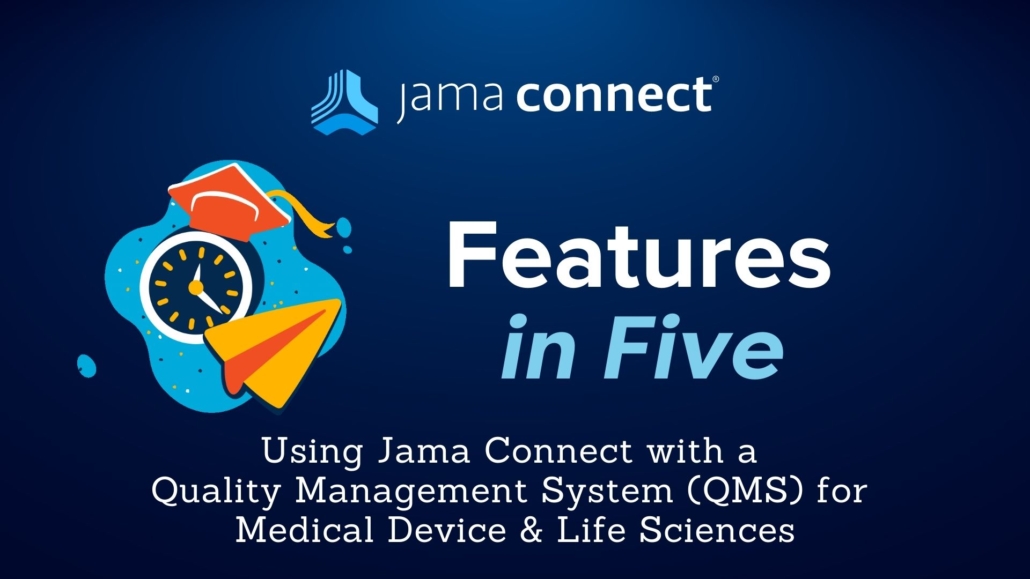
Jama Connect® Features in Five: Using Jama Connect with a Quality Management System (QMS) for Medical Device & Life Sciences
Learn how you can supercharge your systems development process! In this blog series, we’re pulling back the curtains to give you a look at a few of Jama Connect®’s powerful features… in under five minutes.
In this Features in Five video, Steven Pink, Senior Solutions Architect at Jama Software®, will provide insight into how Jama Connect is commonly used in the context of a medical device Quality Management System (QMS.)
In this video, we will:
- Provide insight on how Jama Connect is commonly used in the context of a medical device quality management system
- Demonstrate key features that provide value to those responsible for quality and regulatory matters
- Offer clear guidance on how Jama Connect – a requirements management solution – supplements a separate quality management system within a cohesive ecosystem of complimentary applications
VIDEO TRANSCRIPT:
Steven Pink: Welcome to this segment of Features in Five. I’m Steven Pink, a senior solutions architect at Jama Software and today I’ll be giving an overview to help provide some insight into how Jama Connect is commonly used in the context of a medical device quality management system.
We’ll demonstrate some of the key features that provide value to those responsible for quality and regulatory matters and clear guidance on how Jama Connect, a requirements management solution supplements a separate quality management system within a cohesive ecosystem of complimentary applications.
We often work with medical device or life science companies that have some form of quality management system whether that be paper-based or an eQMS and they’re working to introduce a requirements management solution like Jama Connect for the first time.
For individuals with a quality and regulatory background that have not yet worked in an environment using a formal requirements management solution, this can seem like a foreign and potentially disruptive change to a well-defined process.
RELATED: Jama Connect® vs. DOORS®: Filters, Search, and Analysis: A User Experience Roundtable Chat
Pink: So before we provide some insight to help address that common concern, we want to provide some context as to why an organization would want to introduce Jama Connect in the first place. Prior to using a formal requirements management solution, engineering and R&D are often left managing requirements related data during development in documents, spreadsheets and tools like Jira, Confluence, or SharePoint that are not designed to support complex requirements management.
In this type of scenario, engineering often finds it difficult to manage and maintain complex traceability as they work. So they often leave it to be completed at the end of a phase or milestone as opposed to maintained in real time. This often leads to gaps or errors being identified late in development which is significantly more costly to address the later they’re identified. In addition to having difficulty maintaining traceability, engineering often struggles to manage change to requirements and understand the full impact of each change.
They’ll find it hard to keep data in sync between requirements stored in documents or spreadsheets and other tools like Jira or Azure DevOps where data resides in silos. They’ll often waste a lot of time or effort compiling documentation for their design history file at the end of a given phase before these artifacts can be signed off and stored as an auditable record in a document control system. As products increase in complexity and regulatory guidelines continue to increase in rigor, these challenges grow exponentially for engineering.
To help address these challenges, Jama Connect provides engineering and product teams with a working environment to manage requirements, risks, tests and the traceability between these items in real time. We call this managing live traceability.
RELATED: Buyer’s Guide: Selecting a Requirements Management and Traceability Solution for Medical Device & Life Science
Pink: From a quality and regulatory perspective, Jama Connect’s relationship rule diagram provides a governing structure to ensure that requirement traceability is maintained following proper design controls and quality procedures. This structure makes it simple to manage change, perform impact analysis, and ensure traceability coverage throughout development.
The first thing we see when working on a project in Jama Connect is the dashboard with traceability rules. This makes it easy to understand the expectations for traceability and identify exceptions through dashboard widgets, such as gaps in test coverage or finding unmitigated risks.
With data living and Jama Connect, managing documentation and traceability becomes easier. Once documentation has been authored, it can be sent for a formalized review. Cross-functional teams can utilize the review center to conduct iterative reviews and significantly increase the quality and efficiency of the feedback being given.
Once all items for a given release have been reviewed and approved, these items can automatically transition into an accepted and blocked state, ensuring that changes are not made to approved items unintentionally. When the time comes to generate auditable documentation, Jama Connect allows teams to automatically or manually capture baselines and export these baseline documents out of the system to be signed off in a separate document control system as an auditable record. This process reduces the time spent manually reworking documents as part of the QMS process. And these document export templates can easily be customized to match existing internal quality standards and ensure consistency in the way requirements and other details are documented.
In the end, Jama Connect can help engineering team more easily manage their work and simplify the process of maintaining traceability. As a byproduct of their efforts, quality, and regulatory teams are provided with higher-quality auditable documents without making changes to their existing quality management systems.
RELATED: How to Use Requirements Management as an Anchor to Establish Live Traceability in Systems Engineering
To view more Jama Connect Features in Five topics visit: Jama Connect Features in Five Video Series
